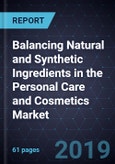Approximately 25–30% of the Personal Care and Cosmetics Ingredients Market is Made up of Natural Ingredients
This growth insights study examines the debate of natural versus synthetic ingredients in the personal care and cosmetic ingredients market, and discusses how the grey zone of synthetic and natural ingredients is leading to consumer confusion and polarization of ingredient categories. It also covers the market, technology and material trends that are impacting ingredient selection during the period 2018–2023. Some of the exemplary cases are provided to understand the delicate balance of quality, efficacy and safety of natural or synthetic ingredients, along with effective growth opportunities and how to address them despite the on-going debate of natural versus synthetic ingredients.
Approximately 25–30% of the personal care and cosmetics ingredients market is made up of natural ingredients, while the remaining 70–75% is attributed to synthetic ingredients. The polarization of the natural and synthetic categories of ingredients is detrimental to the industry, as both categories are needed when formulations are viewed rationally and on a case-by-case basis.
The personal care and cosmetics market are flooded with consumer-media-related buzzwords and labels. This is increasing the polarization between natural and synthetic ingredients. While these buzzwords are aimed at convincing consumers of the advantages of natural over synthetic ingredients, they often devalue synthetic ingredients. This has resulted in confusion in consumer minds over these options.
Key Trends
The key trends, apart from natural trends, that impact ingredient selection for cosmetic formulation are halal beauty, innovation, technology, biotechnology, encapsulation, and multifunctional products. Ingredient suppliers need to leverage these trends to reduce the conceptual gap between natural and synthetic ingredients.
The trend towards natural ingredients must be balanced with all other trends by careful communication about the advantages, features, and benefits without devaluing synthetic ingredients. Formulation experts believe that neither category can be ignored in making effective, safe, and sustainable formulations.
The use of natural ingredients in personal care and cosmetic products needs to be established in more efficient ways. Natural ingredients should be researched, manufactured, and tested using state-of-the-art technologies with emphasis on molecular and body-tissue level structure-function and safety to human health and the environment.
Sourcing and Certifications
The sourcing of natural ingredients should be ethical and sustainable with the proper labeling of plant, animal, and mineral-sourced substances. Certifications for halal, organic, and green labels should be clear and made through credible third-party organizations.
Synthetic ingredients should be marketed confidently by providing well-documented research on their efficacy, safety, and sustainability - especially by highlighting their significant and unique roles in developing multifunctional products, encapsulation, and other formulation technologies, and in biotechnology.
As for natural ingredients, synthetic ingredients must also be discussed at the molecular and tissue levels, by emphasizing their individual and supportive roles in the efficacy, safety, and sustainability of ingredients.








